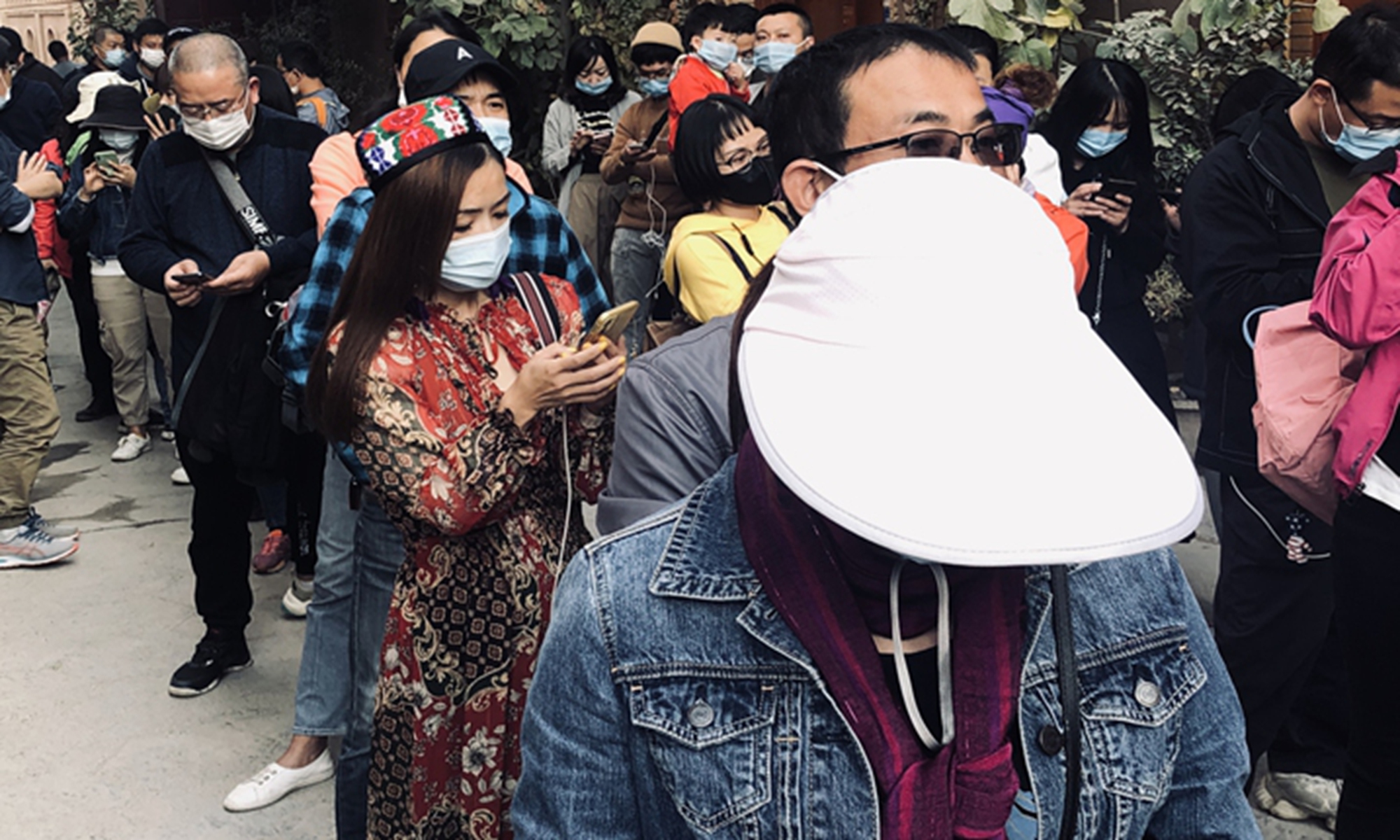Xinjiang may launch more massive tests to curb COVID-19
By Ni Hongzhang and Leng Shumei Source: Global Times Published: 2020/11/4 17:49:52

People are queuing to take nucleic acid tests in the old town of Kashi, Northwest China's Xinjiang Uygur Autonomous Region, on October 25. Photo: VCG
Chinese public health experts said that further rounds of massive nucleic acid testing may be coming in epidemic-stricken places in Northwest China's Xinjiang Uygur Autonomous Region as a large number of silent virus carriers are being discovered, increasing the difficulty of epidemic prevention and control.
They noted that the outbreak in Xinjiang proved the importance of regular tests on high-risk groups and self-protection measures, especially in winter, as the virus is highly contagious.
Xinjiang's Kashi and Kizilsu Kirgiz prefectures kicked off a fourth large round of testing for COVID-19 on Wednesday, which came after Kashi reported 116 new asymptomatic cases and two confirmed cases the day before.
According to local health authorities, the number of existing silent virus carriers in Xinjiang had reached 345 as of Tuesday - 330 in Kashi and 15 in Kizilsu Kirgiz - while there were 64 confirmed cases, unlike previous outbreaks, where asymptomatic cases only accounted for a small part of total infections.
For example, during the outbreak related to the Xinfadi market in Beijing that started on June 11, 335 confirmed cases with 26 asymptomatic cases had been reported as of July 8.
According to local authorities, Xinjiang reported 178 asymptomatic cases after the first round massive testing finished on October 27, another 222 after the second round on October 29, and 345 after the third round on Tuesday.
The discovery of a large number of asymptomatic cases since the beginning of outbreak in Xinjiang suggests that community transmissions may have started in the region, so it is necessary to launch intensive testing to control transmission overall, Jiang Qingwu, a Shanghai-based epidemiologist and former dean of the School of Public Health at Fudan University, told the Global Times on Wednesday.
"What if these silent carriers were not discovered and quarantined but could move freely among the public? The results are predictable," Jiang said, noting that only by finding silent carriers and other potential infections as early as possible, can China cut transmission.
Xinjiang also provides some experience for other places in the country as it proved that regular testing for major groups and early massive screening are very important methods to find and curb infections as soon as possible, especially in winter when the infection risk of respiratory disease increases, experts noted.
Multiple rounds of massive nucleic acid tests are also necessary when the infection source is unclear, experts said.
Zhang Yuexin, a member of Xinjiang's anti-epidemic group, also stressed the importance of self-protection measures in winter, warning that the virus would spread fast once it finds a loophole, especially in villages where residents' anti-epidemic awareness may have weakened as the epidemic overall has been brought under control in the country.
Jiang said that as the epidemic started in a garment factory and silent virus carriers may have contacted many other people before they were discovered, the virus may have already spread among local communities.
The incubation period of the novel coronavirus is anywhere from one to 14 days, but most commonly it is three to seven days. As nucleic acid tests are usually conducted after infection, and people differ from each other in when they show symptoms, asymptomatic cases continued to show up during previous rounds of tests.
Wang Xijiang, a Kashi health official, previously said that the high percentage of asymptomatic cases was due to timely massive nucleic acid testing that discovered silent virus carriers before they started to show symptoms.
If a large number of asymptomatic cases are found in the fourth round of testing, local governments may started a fifth round, depending on the situation, Jiang predicted.
Wang Guangfa, a respiratory expert at Peking University First Hospital, told the Global Times that, in addition to conducting massive nucleic acid testing, it is equally important to conduct epidemiological surveys on discovered infections to find the source, and only under this circumstance can transmissions can be effectively curbed.
Wang said that if rising asymptomatic cases are found among people under quarantine, it is still safe to say that the epidemic in Kashi is under control.
According to Wang Jiangxi, the 116 new asymptomatic cases found on Tuesday were all among people under quarantine, and the two new confirmed cases were previous asymptomatic cases that started to show symptoms.
RELATED ARTICLES:
- Kashi kicks off 4th round of massive nucleic acid tests after discovering 116 silent virus carriers
- Kashi begins 3rd round of mass nucleic acid tests 'to track infections'
- Kashi, NW China's Xinjiang, reported 13 new virus carriers on Monday, all of whom are currently under quarantine: local official
Posted in: SOCIETY,CHINA FOCUS